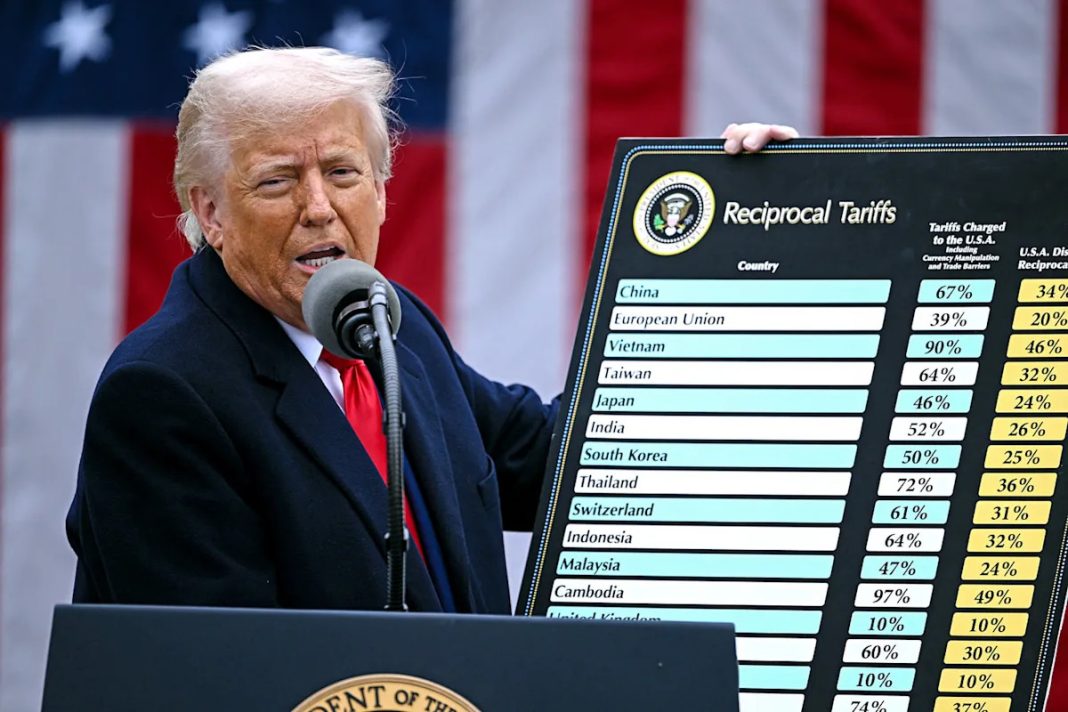It’s Aug. 1, meaning we’ve arrived at the Trump administration’s self-imposed deadline for countries to agree to trade deals with the United States or face even higher new tariffs. Late Thursday, the administration said those tariffs will now go into effect on Aug. 7. It was never going to get anywhere close to hitting the original goal of “90 trade deals in 90 days” — actual trade deals are highly detailed documents that take months, if not years, to complete. But passing such deals was never the goal. What the administration meant was that it would, by today, set tariff rates on our trading partners.
On that, it has made progress. I won’t tick through every “deal” that has been struck so far, (though The New York Times has that list if you’re interested). The modal tariff rate appears to be 15%, as in the cases of the European Union, Japan and South Korea. But other countries face considerably higher rates, including 50% on Brazil and a threatened 25% on India. Instead, I’ll summarize where we are now in President Donald Trump’s trade war, what it means for you and where I think it’s heading.
A good place to start is to explain why I put the word “deal” in quotes. First, actual trade deals create granular trading rules that the countries that sign onto them agree to follow. They define what constitutes a financial institution or intellectual property, how disagreements will be resolved, how labor rights and environmental rules will be enforced and more. And their point is that once countries agree to the terms, existing trade barriers between the signatories come down.
For the Trump administration, trade deals mean something quite different. It starts from the wholly incorrect premise that if we buy more from you than you from us, you are “ripping us off” and must be punished (Brazil is an exception, as Trump wants to punish the country for prosecuting former President Jair Bolsanaro after his attempted coup). This foundational premise makes no more sense than arguing the movie theater is ripping you off when you voluntarily pay for a ticket. Firms import goods and services for the same reason you buy a movie ticket: because they think that it’s worth it to them to do so. Which is why so many are complaining about the tariffs, especially now that they’re starting to really bite.
All that is lost on the administration. The punishment takes the form of tariffs, which are sales taxes on imports, paid at first by the importer, who then tries to pass the costs down the chain to wholesalers and retailers and mostly to the person at the end of that chain: the American consumer.
This raises an immediate, existential question about the trade war. Who is actually getting punished for the sin of trading with the United States? It was with great surprise this week that I heard some outlets describe Trump’s 15% tariff on the European Union as a “win” for the president. In fact, the E.U. as a whole is our largest trading partner. We bought over $600 billion in goods from E.U. member nations last year, with pharmaceuticals and cars making up large shares of our imports.
These purchases will now be more expensive for American consumers. The most up-to-date estimate from the Yale Budget Lab is that the existing set of tariffs will cost the average household $2,400. I’m highly confident — and polls confirm my view — that people paying more for these goods don’t call it a win.
Though it took a while, we now have solid evidence that the trade war is raising prices. You’d expect tariffs to show up in inflation rates for goods (tangible products you can own, like shirts or microwaves) as opposed to services (activities like haircuts or a doctor’s visits). A few months ago, goods inflation was around zero; now it’s tracking 3%. As a Washington Post headline put it: “Shoppers are stressed, but some brands are raising prices anyway.”
For three reasons, I believe we’re seeing only the tip of a spear that’s pointed right at our wallets.
First, Trump is escalating the fight. There was a moment after the first “Liberation Day” on April 2 when tanking markets forced him and his team to temporarily return to reality, pausing the tariffs for 90 days and generally looking for off-ramps. But those days are behind us, in part because markets appear to have, at least for now, adjusted to the trade war, while the hit to consumers is much more of slow burn than a market crash.
Second, the Post article points out that big companies such as Procter & Gamble and Walmart are explicitly raising prices because of tariffs. Other companies, including Ford and GM, and also talking about big, tariff-induced hits to their bottom lines (Ford estimates a $2 billion hit this year). These companies know the Trump administration doesn’t take kindly to such pronouncements. Yet they’re telling it like it is, in part because more consumer pass-through — and thus more price pressures — will be forthcoming.
Third, there were two buffers that heretofore sheltered consumers, both of which are eroding. One was the inventory buildup that started when Trump returned to the Oval Office, as importing firms aggressively stocked up ahead of the tariffs. The other was squeezing profit margins built up during the pandemic to avoid immediately antagonizing inflation-weary consumers. Both buffers worked for a while, but both data and anecdote reveal that they’re winding down.
Finally, I started off this review of where things stand by acknowledging the administration’s progress on setting tariff rates on our many trading partners. What I didn’t tell you is that there’s no chance this will all be somehow resolved today. Trump already extended his own deadline for a trade deal with Mexico, America’s largest trading partner. Anyone thinking “well, this trade war has been chaotic and damaging, but at least it’s all settled” is fooling themselves.
Even the deals that have been announced are nowhere close to being made fully public. They are frameworks about which both sides have different interpretations. For example, Trump thinks the E.U. has agreed to buy $750 billion worth of U.S. energy products and directly invest hundreds of billions more in the United States. But the E.U. says these are unbinding agreements that will be up to the thousands of private companies across its 27 member states! Other big, high-profile deals, like those with Canada, India and even China, also remain very much unresolved.
So that’s where things stand today. Tariffs are raising the costs of domestic production — not a surprise, given that half of our imports are inputs into domestic manufacturing. Those costs are now being passed through in earnest to consumers. The administration doesn’t appear to be seeking off-ramps; if anything, Trump has been escalating the tariffs, hitting trading partners with rates ranging broadly from 15% to 50%. And even the most important deals are still works in progress.
I wish I had better, more hopeful news. But the fact is we are at the mercy of a president who deeply misunderstands the impacts of his actions in this space and is fully unconstrained by any of the traditional checks and balances. I do think that at some point, the politics of making life even more expensive for already economically stressed Americans hurts Trump and the Republicans who accommodate him. But between here and there, there’s a lot of pain to come.
This article was originally published on MSNBC.com

